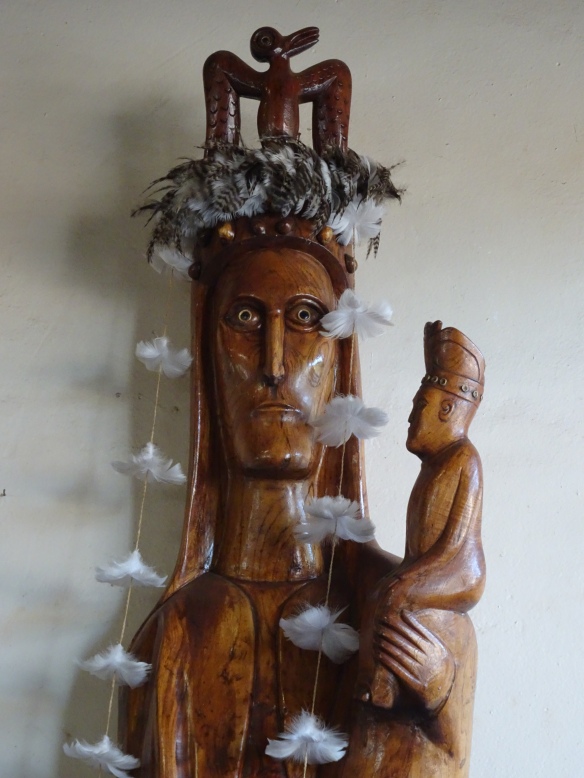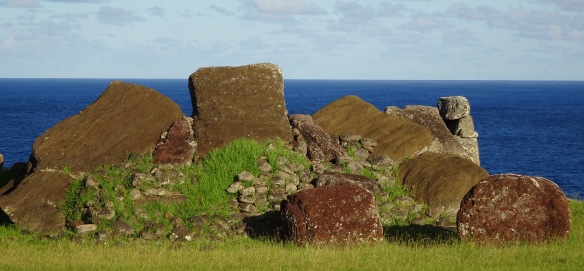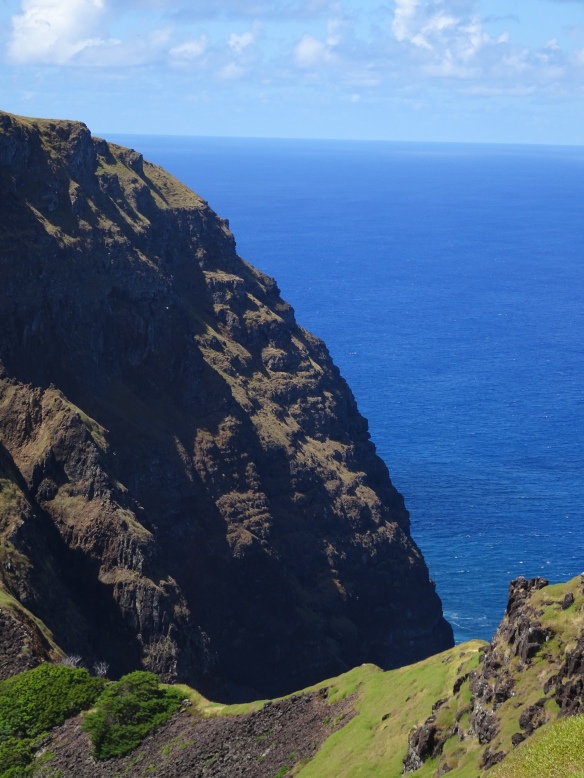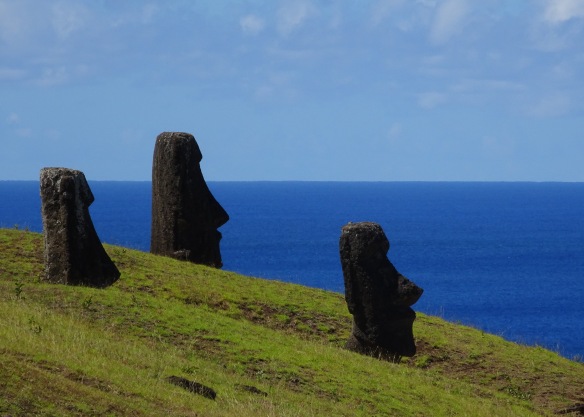I stood at the back of the packed church flanked on one side by a large islander in a multicoloured Tahitian style shirt and on the other by a slighter man in an AC/DC T-shirt and green bandana. As a building it was plain on the interior but made memorable by some truly handsome carving in a light, orange hued wood. The figures were of a familiar religious nature but rendered unusual by the stylised forms and unorthodox paraphernalia.

Strangest of all was what looked at first like a statue of an angel with outstretched wings, but instead of a cherubic head was that of a long beaked bird. The service was conducted in both Spanish and Rapa Nui with some English thrown in at the beginning for the benefit of the foreigners. The hymns were sung in Rapa Nui to the accompaniment of a rhythmic drum beat, tapped wooden sticks and a ukulele which were played by three stocky men who stood and swayed gently in the front row in time to the music.
Two priests were officiating, both wearing deep purple robes hemmed in gold and white braiding. One was bare headed but the other sported a magnificent headdress of soft white feathers which fanned out from the front of a headband. He began a discourse in Rapa Nui in a strong voice and the language, spoken with stressed consonants and syllables, had a powerful and emphatic ring. On finishing he sat down behind a table dressed in white cloth with three lit candles in both front corners. His gold painted chair was placed directly beneath a large dark wooden cross on which hung a lighter wooden carving of the crucified Christ. As his counterpart delivered a long sermon in Spanish he seemed to slump into the chair but at a call to prayer he sprang back to life and stood, his headdress coming level with the feet of the Christ on the cross. The feathers must have caught the draft of a ceiling fan as they began to move like an anemone in a current of water. From where I stood it appeared as though the headdress turned waving anemone was tickling the feet of Christ. It was an image both amusing and slightly awful.

Later that afternoon we drove our aged Suzuki jeep up a deeply rutted track to stop beneath the only tree of any size that afforded some shade. The sun beat down with a savage ferocity and we applied sun cream like an aged dowager applies foundation and loaded up on water. Our hike would take us out onto a side of the island seldom visited and in fact we did not see a single soul for over 4-hours. Neither of us had expected the island to be so beautiful being volcanic in origin and having been stripped of much of its native flora. But surrounded on all sides by the magnificent cobalt blue Pacific Ocean, with towering cliffs, and a wild prairie landscape strewn with jagged boulders and rocks it had a preternatural intensity and savage charm. Our gaze was continually drawn to the seemingly limitless horizon. What is it about staring out over oceans that is so conducive to contemplation and imbuing a sense of deep calm. The sense of remoteness was intense, a feeling of being off the map, at the edge of human existence. A line from an Elton John song drifted into my mind ‘ . . . It’s lonely out in space . . . ‘.
But amongst this blasted and twisted rock landscape lies a terrible tale, one which nearly every pile of rocks bears testament to. There are over 350 Ahus, or burial platforms constructed of volcanic boulders, on which stood possibly the most iconic stone carvings in the world, the Moai. Most now lie in ruins. We found many Ahu that afternoon and the toppled Moai which once stood on them. Most of the Moai lie face down, as though in disgrace and one finds oneself asking, “What happened here, what terrible events led to this?’

The reasons for the island-wide destruction of the Moai are still highly controversial. But after abandoning megalithism and ancestor worship the local tribes converted to a cult centred on the Bird Man. At the Orongo ceremonial village on the crater rim of volcano Ranu Kau the most important event in the year took place. Male representatives from each tribe would climb down the 1,000-foot cliffs, swim to a small offshore island, Motu Nui, and await the return of the Sooty Tern. The first to get an egg, swim back, climb the cliffs and present the egg would gain enormous privilege and prestige for both himself and his tribe.

But in spite of this extraordinary annual feat by the second half of the 19th-century things were going badly wrong on Rapa Nui. Ecologically bankrupt, early European reports talk of a descent into barbarism. In 1863 a Peruvian slaving raid deprived the island of 1,000 islanders and even the survivors return, under intense pressure from the Catholic Church, did not help as they brought new and lethal diseases back with them. By 1877 there were only 111 Rapa Nui left.
But in a bizarre twist of fate the cult of the Bird Man has proved to be the island’s saviour, although perhaps not as those early Rapa Nui might have imagined. In 1967 regular flights began between the island and Santiago in Chile and today a huge Boeing 787 delivers a daily load of dollar laden visitors. Tourism has proved to be the ‘goose – or should that be Sooty Tern – who lays the golden egg’. An egg which now drives almost all of the economy, although not without bringing its own attendant problems.

It was hard to leave the island. In a very short space of time it had worked its magic on us with its wild, empty, mystery-filled corners and those extraordinaryly impassive statues peering down the ages at us.


Hi D,
Are you in Rapa Nui now? It looks absolutely stunning. The church service sounds like some of the ones we experienced in Guatemala in the 1990s a very strange mixture of the familiar and the occult.
Looking forward to seeing you both in just a few weeks. Let me know if you have any particular culinary cravings – curry, trifle? You name it and it will be on the menu…
Lots of love
Sent from my iPad
>
LikeLiked by 1 person
Thanks for a glimpse into this far flung mysterious island David? Interesting read & beautiful pictures…what stunning views! How old are the statues thought to be?
Love to you both, & safe journey to the USA!
LikeLiked by 1 person
Hi Camilla, the jury is out on when the first people arrived on the island: 700 – 1100AD. They stopped carving he Moai around the mid 18th-century. Now in the US but have an 11-hour delay!!!!!! D xx
LikeLike